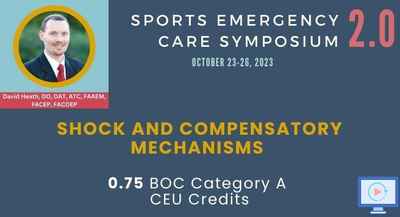Course Info (Learning Objectives; Practice Gap; Clinical Bottom Line; Summary Conclusions)
Course Description:
"Exertional Heat Illnesses: Pediatric vs. Adult Management" aims to provide participants with a comprehensive understanding of the epidemiology, classification, and nomenclature of EHI. Through an exploration of the pathophysiology and clinical presentations of different types of EHI in prepubertal and adolescent/adult patients, participants will recognize the thermoregulatory differences and risk factors associated with pediatric EHI. This knowledge can be applied to make evidence-based decisions regarding the prevention, recognition, management, and care of EHI, with a focus on the spectrum of EHI. Ultimately, this presentation emphasizes the importance of understanding the nuances of EHI management in patients of different ages to optimize care.
BOC Domains of Athletic Training:
- Domain I - Risk Reduction, Wellness, and Health Literacy
- Domain II - Clinical Evaluation and Diagnosis
- Domain Ill - Critical Incident Management
Practice Gap:
Despite the importance of understanding the differences in thermoregulation and risk factors associated with pediatric exertional heat illness (EHI), there is a lack of knowledge and awareness among athletic trainers and other healthcare providers. This knowledge gap may lead to ineffective prevention, recognition, management, and care of EHI in pediatric patients, resulting in poor outcomes and increased morbidity and mortality. Therefore, there is a need for educational interventions that focus on the epidemiology, classification, and nomenclature of EHI, as well as the pathophysiology and clinical presentations of different types of EHI in prepubertal and adolescent/adult patients, to equip healthcare providers with the knowledge and skills needed to make evidence-based decisions and optimize care for patients of different ages. This practice gap can be addressed by providing targeted education and training on the spectrum of EHI, with a focus on pediatric management, within the BOC domains of athletic training.
Learning Objectives
Upon completion of this course, participants will be able to:
- Gain an understanding of the epidemiology, classification, and nomenclature of exertional heat illness (EHI);
- Recognize pathophysiology & clinical presentations of different types of EHI in prepubertal & adolescent/adult patients with a focus on the spectrum of EHI;
- Recognize risk factors associated w/ EHI;
- Recognize thermoregulatory differences associated w/ pediatric EHI;
- Apply knowledge to make appropriate evidence-based decisions regarding prevention, recognition, management & care of EHIs.
Clinical Bottom Line:
After reviewing the epidemiology, classification, and nomenclature of exertional heat illness (EHI) and understanding the pathophysiology and clinical presentations of different types of EHI in prepubertal and adolescent/adult patients, it is evident that there are differences in thermoregulation and risk factors associated with pediatric EHI. Clinicians should apply this knowledge to make appropriate evidence-based decisions regarding the prevention, recognition, management, and care of EHI in patients of different ages, with a focus on the spectrum of EHI.
Summary Conclusions:
- Understanding the epidemiology, classification, and nomenclature of EHI is crucial in making evidence-based decisions for its prevention, recognition, management, and care.
- There are differences in thermoregulation and risk factors associated with pediatric EHI, which clinicians should consider when making decisions.
- The spectrum of EHI should be the focus of management and care, with attention given to the different types of EHI and their clinical presentations in prepubertal and adolescent/adult patients.
- By applying this knowledge, clinicians can effectively prevent, recognize, manage, and care for EHI in patients of different ages, leading to better outcomes and reduced morbidity and mortality.


